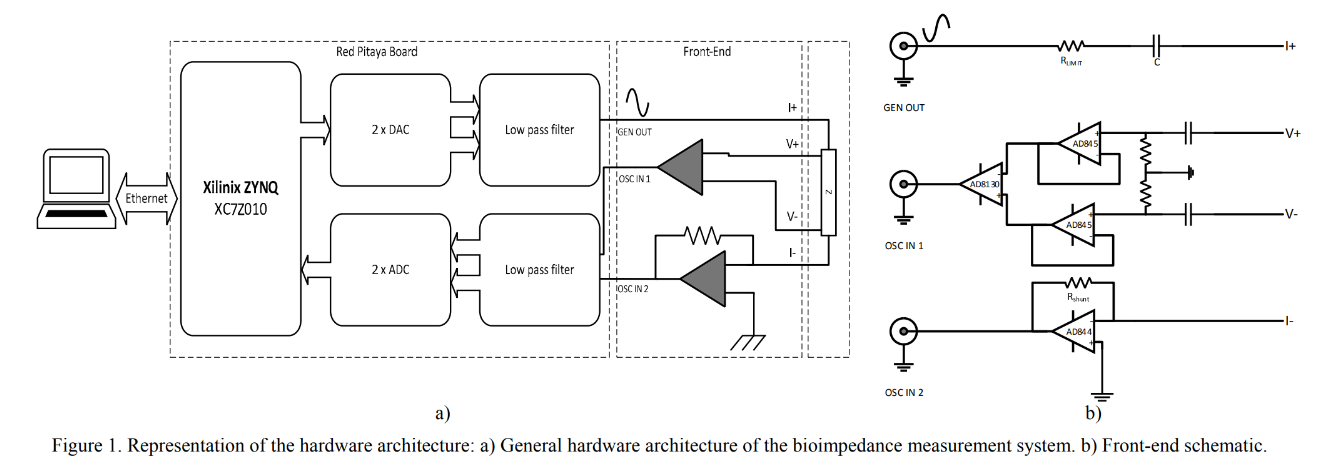Advancing Gastroenterology Research with a Portable Bioimpedance Measurement System Based on the Red Pitaya Platform
- Posted by
 Red Pitaya Team
, May 7, 2025
Red Pitaya Team
, May 7, 2025

Bioimpedance spectroscopy (BIS) has revolutionized how we understand biological tissues and monitor physiological events. By measuring impedance across a range of frequencies, this technique provides crucial insights into tissue conditions and abnormalities. A recent innovation in this field comes from the development of a portable bioimpedance measurement system, leveraging the Red Pitaya platform to deliver real-time, cost-effective, and precise analysis for applications in gastroenterology.
The Need for Real-Time Bioimpedance Systems
Bioimpedance analysis is vital for understanding biological processes. At low frequencies (<1 kHz), current flows through extracellular fluids, while at high frequencies (>1 MHz), it penetrates cell membranes and intracellular fluid. This behavior allows researchers to detect conditions such as inflammation, ischemia, and tissue abnormalities.
Conventional systems, although accurate, often fall short for advanced biomedical applications due to limitations such as low sampling rates, inadequate electrode configurations, and lack of portability. Addressing these challenges, the research team developed a portable 4-terminal bioimpedance system tailored for real-time, in-vivo measurements.
Leveraging Red Pitaya for Bioimpedance Spectroscopy
Central to this innovative system is the Red Pitaya platform, renowned for its versatile signal generation and processing capabilities. Paired with custom front-end circuitry, the setup utilizes the auto-balancing bridge method to measure bioimpedance in a range of 10 Ω to 10 kΩ across frequencies from 10 Hz to 1 MHz.
System Overview
The system comprises:
- Red Pitaya Board: Generates sinusoidal excitation signals and processes real-time impedance data.
- Custom Front-End Circuitry: Injects current into the sample and measures voltage and current for impedance calculations.
- Software Interface: Built with LabVIEW and MATLAB, enabling users to visualize data, perform Cole-Cole modeling, and analyze electrical properties.


This setup ensures high accuracy (deviation <2%) and reliable performance, making it suitable for delicate biomedical measurements.
Hardware Innovations
A key feature of this system is its 4-terminal auto-balancing bridge design, which overcomes issues of electrode polarization at low frequencies. High-frequency challenges, such as parasitic capacitances, are minimized with a careful front-end design using operational amplifiers and impedance-limiting components for patient safety.


Safety and Portability
- Patient Safety: A 10 kΩ resistor limits current flow to 100 μA, ensuring compliance with medical safety standards.
- Portability: The compact design fits within the instrument port of a standard endoscope, enabling in-vivo measurements.


Testing and Validation
The system underwent rigorous testing to ensure its accuracy and reliability in measuring bioimpedance. Initial evaluations were conducted using equivalent circuit models that simulated cell suspensions, allowing the researchers to validate the system's precision. These tests demonstrated the system's capability to handle a range of impedance values and frequencies, confirming its suitability for biomedical applications. Further testing involved tissue excised from the distal colon of a guinea pig, providing a real-world scenario to assess the system’s performance in detecting bioimpedance variations in biological tissues.


Key Findings
The results from these tests revealed that the system exhibited minimal deviations, with a standard deviation of less than 0.02% for magnitude and less than 0.47% for phase measurements. Distinct dispersion regions were identified in the colon tissue excised from a guinea pig, consistent with prior studies on ischemic tissue damage. These findings underscore the system's effectiveness in detecting physiological abnormalities, such as inflammation or pre-malignant tissue changes, demonstrating its potential as a valuable diagnostic tool in gastroenterology.
Applications in Gastroenterology
The portability and real-time analysis capabilities of this system make it an invaluable tool for studying a range of gastrointestinal disorders. One of its primary applications is monitoring tissue health by identifying ischemic damage or inflammation within the gastrointestinal tract. These capabilities enable early detection and monitoring of tissue conditions that might otherwise go unnoticed. Additionally, the system shows promise in exploring pre-malignant conditions, such as detecting abnormalities associated with Barrett's esophagus or identifying mucosal injuries. By providing precise and real-time insights into tissue conditions, the system could play a pivotal role in advancing diagnostic practices in gastroenterology.
Comparison with Commercial Systems
When compared to existing bioimpedance analyzers, the bioimpedance measurement system based on the Red Pitaya board offers:
- Comparable accuracy (<2% deviation for impedance values up to 10 kΩ).
- Wider frequency range (10 Hz to 1 MHz).
- Enhanced portability and safety for in-vivo use.
- Real-time measurement and wireless data transfer capabilities.
Future Directions
The system has the potential to revolutionize bioimpedance analysis in gastroenterology. Planned improvements include refining high-frequency accuracy and exploring additional applications in tissue diagnostics. By combining portability, real-time processing, and advanced analytics, this innovation paves the way for new breakthroughs in medical research.

.jpg?width=767&name=blog%20featured%20image%20(82).jpg)
.jpg?width=767&name=blog%20featured%20image%20(81).jpg)
.jpg?width=767&name=blog%20featured%20image%20(80).jpg)
.jpg)
.jpg)